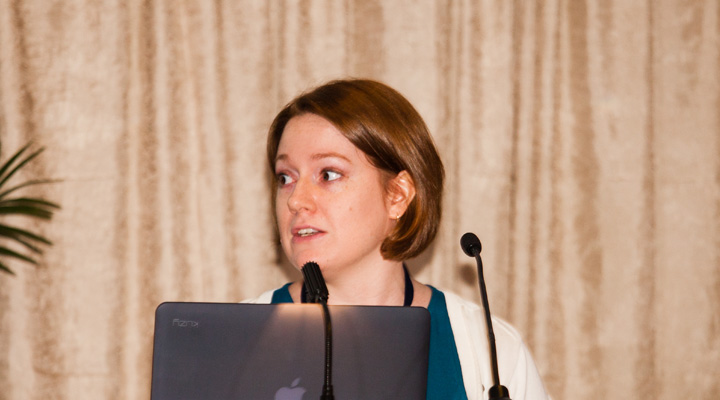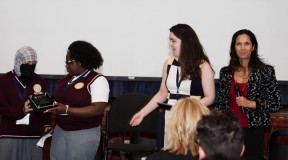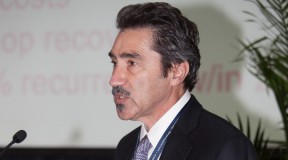Endofound’s Sixth Annual Medical Conference: Ending Endometriosis Starts at the Beginning
My name is Jenny Hancher and I am the Education and Outreach Coordinator here with Endofound and I work on the ENPOWR Project.
For those of you who do not know the ENPOWR Project is Endofound’s Education and Outreach Program, so we actually go into schools and community based organizations throughout New York State and presenting to teens and educating teens about endometriosis.
To just give you a little background on the ENPOWR Project – the ENPOWR Project started in 2013. We received a grant from Senator Jeffrey Klein who provided us with some money to actually get started and actually pilot the program, which we did in the fall of 2013. In spring of 2014 we were able to expand and include some interns to really help us expand our reach throughout the New York City and the Long Island area. In April of 2014 we received a second grant, which really helped to exponentially expand our program. Jeffrey Klein, again, has been so instrumental in really pushing this program forward. Without his support we would not have this program.
In the fall of 2014 we were able to include two full-time staff persons who focused specifically on ENPOWR and included additional interns and expanded upstate to Albany, to Rochester, to Syracuse. Our interns are all MPH graduate level students or undergraduate students. They have really helped to expand our program.
What actually is EMPOWR, what do we do? We go into schools, primarily schools. We started in New York City and as most of you know, because I know most of you are probably from the area, the New York City public school system is the largest in the country. It is a great place to pilot a program like this. Our presentations are 45 minutes in length and are differentiated to fit a variety of audiences. If we are talking to a health class or talking to eighth graders as opposed to seniors we change up our program. We have presented in health classes and living environment classes. We even presented in creative writing classes or for 400 person assemblies. Basically we will talk to anyone who is willing to have us in and talk about endometriosis to these teens.
We do present to co-ed classes. We believe it is incredibly important for young boys to know as much as young girls about endometriosis. They have mothers, they have sisters, they have friends and they can help spread awareness just as much as the girls.
The ultimate goal of these presentations is really to get girls to seek treatment who may have these symptoms or are hearing about it for the first time. But we are also trying to spread awareness about endometriosis and really start a dialogue that as you all know does not really exist.
We are also trying to teach the teens to advocate for their own health, it is a big part of the message that we send. We really want to start a conversation about menstrual health, health in general. A lot of these teens are heading out to college for the first time. They are going to be on their own for the first time a year or two after we talk to them. We really want to teach them ownership of their own health to start a healthy life going forward.
We get these presentations through a variety of methods. We email teachers, we send mailings out, we make calls. We make connections with sites. Typically, if we are at a site they ask us back. We actually have a 91 percent rate of return with these presentations, with either a site having us back or expressing interest in having us back, which shows you how important it is to these teachers once we are in for us to be back in their classrooms consistently.
We are always looking to expand our network too so this is where you guys can be really helpful. One of challenges is actually getting into these schools finding the person who is going to let us in and say “hey this is a really important thing for you to do with our students”. If you guys have existing connections with schools, with CBOs, those sorts of things, please contact us and help us get into these schools because if you guys have those connections it makes it that much more easy to get in to these schools.
We have seen that this program is effective. Teens are very receptive to this information. We give a pre-test and a post-test with every presentation that we give. On average, with the pre-test kids are scoring about 30 percent, which shows, as you guys know, most people have not even heard of it. And we ask the kids to raise their hand if they have heard about endometriosis and every single hand in the room is not up. If there is one up it is kind of an anomaly. But, for the post-test on average kids are scoring 91 percent. Again, this is showing that this is an incredibly effective presentation and that they are getting a lot out of it.
On those post-tests we have some qualitative questions that we ask; one of them is “what is the most important fact you learned today”. So I want to share a couple of those with you. From the girls here are a couple of things they have said. One girl aged 16 said, “I learned that I may have the disease and that my long periods and longs periods and having cramps may not be normal. I shouldn’t have to miss school for this”. Another student, another girl aged 17 said, “I’ve learned that if I feel something is seriously wrong with my body that I should follow my instincts and seek help. And not listen to the people telling me I’m being dramatic”. A third girl, aged 14 said, “I’ve learned of the symptoms of endometriosis and to keep track of symptoms and to go check with the doctor. I also learned that I need to spread information about endometriosis”. These three girls are all saying exactly what we are trying to teach with this presentation. That it is important for them to now their own bodies, to advocate for themselves and to spread awareness to those around them.
But it is not just the girls who are getting a lot out of these presentations, it is also the boys. Here a couple of things some boys have said and keep in mind these are high school aged boys. One boy aged 17 said, “A symptom of endometriosis is a heavy and painful flow, which is something one girl I remember from middle school talking about”. So they are aware of these things. Another boy said, “Just because endo affects women it is very important and not something I should ignore”. A third one said, “The effects and the definition of endometriosis, moreover I learned what I could do to help as a male”. So we are really empowering these young men to also go out and help those women in their lives, which is really important.
The teachers are also getting a lot out of this. We went to a conference of the Science Teachers’ Association of New York State in Rochester last November. One teacher came up to myself and my co-worker Katie and said, “You know I’ve got this girl and every month she’s crawled up in a ball during her period. She is crying during class, could it be this?” I said, “Well yeah, it very well could be this”. He sat and he talked to us for about 15 minutes really trying to get this information so he could go relay it back to the student. Teachers are great for that and they can also, with these classrooms even if we do not go back for presentations, they can still spread that information to their students for years going forward.
Talking about schools that have been incredibly important to the ENPOWR Project there is one network that is above and beyond other schools in getting us in and having us help and this is the Young Women’s Leadership Network. They are a privately funded public school for young women and they have five schools throughout the five boroughs. They work to empower young women to achieve their higher education goals. They take what they call a “whole girl” approach. This means teaching them not only just about biology and calculus but also teaching them about their own bodies. One teacher in some presentations we gave, we gave nine presentations in Queens in December reaching almost the entire Queens school, and one teacher before every class kind of embodied what this whole system seems to embody. She had her students repeat after her and say, “I’m healthy, I’m strong, I’ve got it going on”. Which is – it is empowering. It is what this network stands for, to really empower young women to be the best that they can be and to really know their own bodies.
Their school in Harlem had us in a couple of weeks ago doing a health fair. We also did some presentations. Again, these two schools, we hope to get into the others in the network, have just gone above and beyond to really advocate for the health of their own students. They are just an example of one school system that we have worked with.
Moving forward – we hope to continue to expand throughout New York State. As I said we have been in several areas but there are several areas that we have not. We are trying to expand into those areas. This is actually where you come in and where you guys can help. People like you are what make this program a success. Like I mentioned earlier, people in New York City who have contacts in the education program or CBOs our cards are in the back. Same thing goes for you who are upstate. Grab one of our cards; you guys may be able to help us get in these areas we have not been in before. You guys know how important this disease is and you can be our best advocate in those areas where we physically are not.
Feel free to take our cards in the back. Also take a look at the banner that is above the table with all the materials. That was actually signed by a bunch of women from the Young Women’s Leadership Network at the East Harlem school we were in a couple of weeks ago. It is all the girls explaining why it is so important that we raise endometriosis awareness. Thank you.










